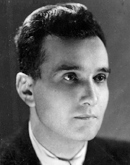

Giuseppe Terragni
*18. 4. 1904 – Meda, Italy
Biography
Giuseppe Terragni was an Italian rationalist architect whose work is associated with Italian fascism. At the age of seventeen, he enrolled at the technical university in Milan, where he graduated in architecture in 1926. As early as 1925, he participated with Pietro Lingeri in a competition for a monument to the fallen in Como. In 1926-27, articles deemed the manifesto of Italian rationalism were published in the weekly Rassegna Italiana, signed not only by Terragni but also by Libera, Figini, Pollini, Frette, Larco, and Rava. In 1926, he founded a group of architects called Gruppo 7, which was close to Italian fascism while also being radically modernist. In the same year, he opened a studio with his brother Attilio in Como. His career began with the reconstruction of the façade of the Metropoli-Suisse hotel in Como. From 1927 to 1929, the realization of his project for the Novocomum building in Como took place. The construction sparked scandal and protests from several architects. From 1928 to 1932, he participated in the first and second exhibitions of rational architecture in Rome, Brescia, and Florence. A year later, he submitted his design sketch for the monument to the fallen in Como. The Fascist House in Como, which he designed and which was built from 1932 to 1936, elevated him to the status of an international architect. In 1933, together with friends, he founded the newspaper "Quadrante," which was published under the leadership of Piero Bardino and Massimo Bontempelli. In collaboration with Pietro Lingeri, he designed "Le cinque case" in Milan, which was built from 1933 to 1936. From 1938 to 1940, he worked on other projects: the revision of zoning plans in Como, Danteum in collaboration with Lingeri, and Casa Giuliani Frigerio - his last masterpiece. In 1940, he was called to war, where he first fought in Yugoslavia and later in Russia. In 1943, he was injured and returned to Italy.
Giuseppe Terragni was an Italian rationalist architect whose work is associated with Italian fascism. At the age of seventeen, he enrolled at the technical university in Milan, where he graduated in architecture in 1926. As early as 1925, he participated with Pietro Lingeri in a competition for a monument to the fallen in Como. In 1926-27, articles deemed the manifesto of Italian rationalism were published in the weekly Rassegna Italiana, signed not only by Terragni but also by Libera, Figini, Pollini, Frette, Larco, and Rava. In 1926, he founded a group of architects called Gruppo 7, which was close to Italian fascism while also being radically modernist. In the same year, he opened a studio with his brother Attilio in Como. His career began with the reconstruction of the façade of the Metropoli-Suisse hotel in Como. From 1927 to 1929, the realization of his project for the Novocomum building in Como took place. The construction sparked scandal and protests from several architects. From 1928 to 1932, he participated in the first and second exhibitions of rational architecture in Rome, Brescia, and Florence. A year later, he submitted his design sketch for the monument to the fallen in Como. The Fascist House in Como, which he designed and which was built from 1932 to 1936, elevated him to the status of an international architect. In 1933, together with friends, he founded the newspaper "Quadrante," which was published under the leadership of Piero Bardino and Massimo Bontempelli. In collaboration with Pietro Lingeri, he designed "Le cinque case" in Milan, which was built from 1933 to 1936. From 1938 to 1940, he worked on other projects: the revision of zoning plans in Como, Danteum in collaboration with Lingeri, and Casa Giuliani Frigerio - his last masterpiece. In 1940, he was called to war, where he first fought in Yugoslavia and later in Russia. In 1943, he was injured and returned to Italy.
The English translation is powered by AI tool. Switch to Czech to view the original text source.










